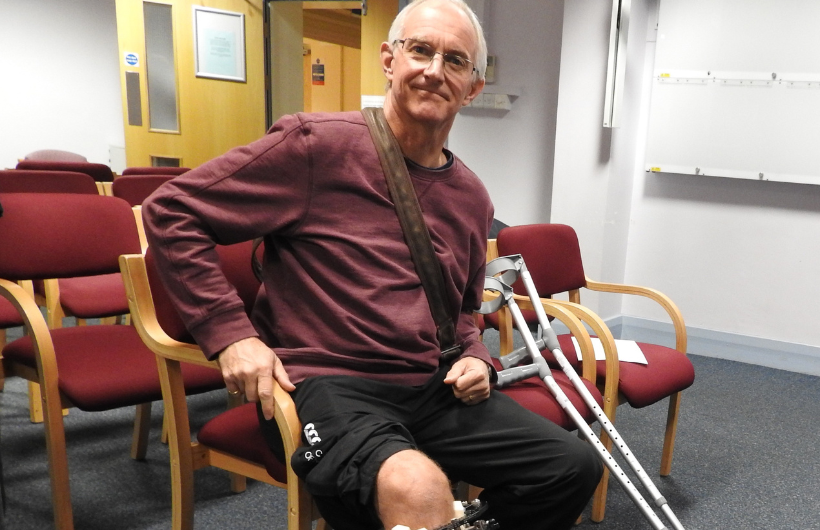Simon had his leg straightened
Simon took the brave decision to have his bowed leg straightened. He explains below.
Part 1 - Straightening my leg
I was diagnosed with Paget’s Disease of the right tibia in 2014, at the age of 55. I have had 3 intravenous bisphosphonate infusions at the RNOH, with a good result but I was left with the classic sabre-shaped bowing of the tibia, both forward and outwards. This was gradually damaging my knee and ankle joints, walking was painful and I needed to use a stick.
On 27 October 2016, a Consultant surgeon at the RNOH, who specialises in Limb Reconstruction, broke my right tibia and fibula (a double osteotomy) and fitted a Taylor Spatial Frame. We make daily adjustments to the frame, to bring the knee and ankle into the correct alignment and progressively straighten the tibia. The adjustment program is almost complete, then I expect to continue to wear the frame for another 4 months whilst the bone mends and strengthens. The pain is less acute now but caring for the pin sites and walking in the frame are not easy but it will be worth it. At the end, the hope is that my leg will be straight, I will be able to walk unaided, without pain and without further damaging my knee and ankle.

Part 2 - An Interesting Journey
When I saw my orthopaedic surgeon at the Royal National Orthopaedic Hospital (RNOH) in October 2016, he said to me that straightening my right leg (which has Paget’s disease in the right tibia) would take about 6 months to achieve. Well, he was absolutely spot on! The Taylor Spatial Frame that did all the straightening work came off exactly 5 months post-surgery, then the plaster cast that replaced it came off a month later; almost 6 months to the day. As I write this, it’s 6 weeks since the plaster cast came off.
It’s been an interesting journey so far. In October 2016, the surgeon broke my tibia and fibula, then fitted the frame, which had bolts screwed into the tibia, as well as wires going right through the bones and out the other side of the leg! Following the surgery, I spent a week in hospital at the RNOH. We then began a programme of daily adjustments to the frame – my wife used a spanner (yes, really!) to move each of the 6 struts by 1mm per day. The adjustments were overseen and amended by the consultant, at clinic visits, every week or two, for about two months. Just before Christmas 2016, he announced that I had finally achieved a “well-aligned limb”. Then came the slow bit... We had to let time and my body work its magic and repair the leg. With the frame locked off, and no more adjustments to make, we waited patiently for new bone to grow into the gaps/breaks in my tibia. By comparison, it makes watching paint dry a positively sprint event!
However, over the next 4 months, we watched as new bone progressively filled in the fractures. It’s strange to watch. When you look at the x-rays, it looks a lot like ‘wispy clouds’ or ‘cotton wool’ forming in the gaps between the bone; we called it ‘bone fluff’. At this stage, I attended clinics monthly and you could clearly see the progression of bone growth between successive sets of x-rays.
At 4 months, I had the lower ring of my frame removed, to help with mobilisation of the leg. At 5 months, bone regeneration/growth in my tibia was good enough to have the frame completely removed (under general anaesthetic). It was replaced with an above knee plaster cast for the final month but it was just bliss to finally be rid of the frame!
During the whole 6-month period, I walked with crutches, trying to fully weightbear through my leg, as much as comfort would allow, which has helped to stimulate bone growth. I am delighted to report that, despite Paget’s disease and 3 bisphosphonate infusions to treat it before surgery, my bone growth/regeneration has been ‘normal’, which has been hugely encouraging. Even so, there have been times when the straightening process has been a real struggle for me. I had serious discomfort and pain in the early stages, the regime of weekly sterile dressing changes to the 15 pin sites (where the frame was attached through my leg) was painstaking and just everyday living with a 2Kg frame/cage attached through your leg is complicated. It pretty much affects every aspect of your life.
All that said, it has been worth every minute, to achieve the outcome of a straight leg that I can finally walk on again. I’m not quite there yet, but nearly. I am walking with two sticks but the bone is strengthening, wasted muscles are recovering and I am driving a car again. I have regular physiotherapy to help improve strength and mobility. I look forward to a progress review in 6 weeks, to make sure that bone regeneration has continued and the fractures are fully healed. My fibula is still not fully united, but I’m working on it!
Simon
Watch this video to hear Simon explain his experience

